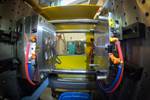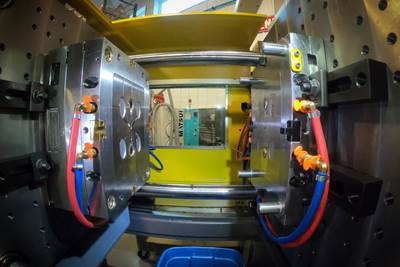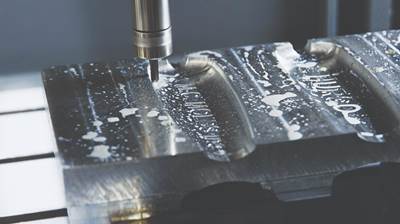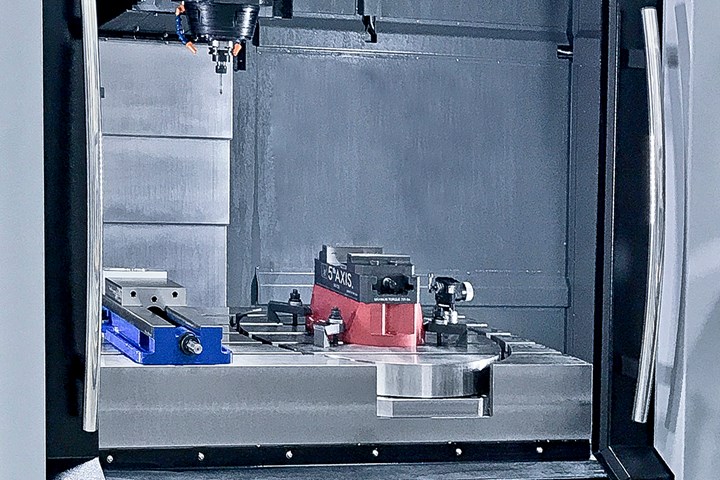
Machine design can offer an incredible amount of flexibility for the user. In addition to fixturing multi-sided work on the C-axis table, a stationary vise can be placed on the fixed portion of the table to machine three-axis or four-axis work. Photo Credit: Hurco Companies
Several common machine configurations for five-axis machining are available today and each one has its own set of strengths that makes it stand out among other available options.
Trunnion Table Machine
One of the most common configurations—or at least the one most people identify with when they hear the term five-axis machine—is the trunnion table machine. The trunnion configuration can also be referred to as a table-table configuration because both rotary axes are contained in the trunnion table itself, and the head is always stationary.
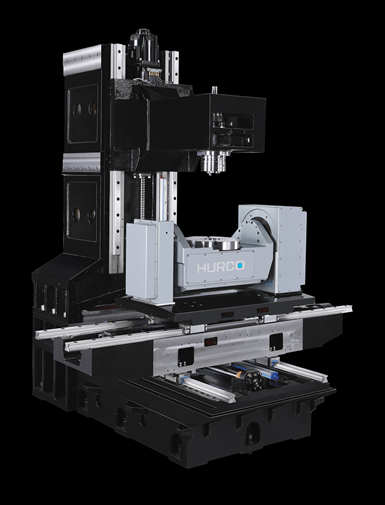
A trunnion-style five-axis machine without the sheet metal.
Most operators and programmers can easily identify with this setup because it is a simple process progression from standard three-axis machining. Since the two rotary axes are often only used to locate the workpiece into the desired orientation, it is easy to visualize how the machine will position and behave during machining.
Compared to other machine configurations, the trunnion machine will offer better undercut capabilities because the table can tilt farther (at least in one direction) than the swivel head designs (110 degrees), which provides more access to the underside of a workpiece. The trunnion configuration can also give the operator a larger overall usable work volume. The table tilts and locks into position, which gives the X, Y, Z axes their full range of travel.
The trunnion style of the machine can also be a better choice for heavy metal removal.
In a swivel head machine design, some of the overall work envelope must be used to accommodate the length of the tool as the head tilts back and forth. This scenario can be magnified when machining with longer tools, impacting the overall work envelope tremendously.
The trunnion style of the machine can also be a better choice for heavy metal removal. This machine type will usually offer more torque at lower rpms because the head doesn't articulate, enabling the use of geared or belt-driven spindles. This stationary head design will also eliminate the possibility of pushing the head out of position while machining, which can sometimes happen on swivel head machines during extremely heavy cuts.
Swivel or Articulating Head Machine
The next machine configuration is the swivel or articulating head machine. This type of machine can be either a head-head configuration, where the head completes all rotations and the table is stationary; or the head-table configuration, which consists of a tilting head and a rotating table.
This head-head or head-table design enables you to machine much heavier parts than the trunnion design. Since the table doesn't tilt, the part's entire weight is transferred directly down through the machine's base and onto the floor, making this a very rigid setup for larger parts. Also, the design of the table itself—in contrast to the trunnion-style machine—allows for larger parts regardless of weight because the trunnion is limited by the size of the part that can be placed between the table risers.
This head-head or head-table design enables you to machine much heavier parts than the trunnion design.
Also, the rotating head permits shorter or more standard-length tooling when machining because all rotations of the tool happen above the part. On a traditional A/C trunnion-style machine, the spindle has to reach out over the tilting table, and the closer the table tilts toward 90 degrees, the more the spindle has to reach. This will often cause the operator to use longer than the desired tooling to accommodate for this scenario.
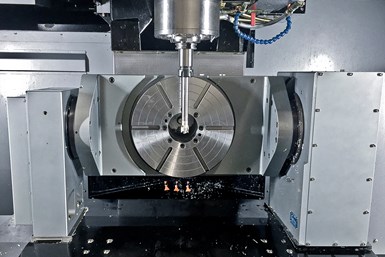
Traditional A/C trunnion-style machines should be purchased for the size of work they will be running. Running smaller parts on a larger machine can bring about the need for extended length tooling.
This also means that when purchasing an A/C trunnion-style machine, you need to think about the size of the work you will be running on the machine and size it accordingly (i.e., the smaller the work, the smaller the machine). However, this limitation isn't present on the B/C-style trunnion machine because the table tilts left and right (B-axis), which means the tool can position on either side of the rotating table and never needs to reach out over it from behind.
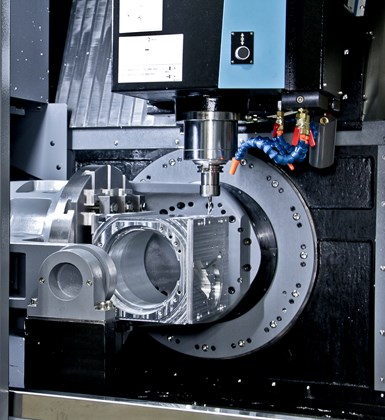
B/C-style trunnion machines can offer more flexibility in part size. Because the head doesn’t need to reach over the casting, you can use standard length tooling to machine smaller parts.
The head-table design can be more versatile than a trunnion or head-head type of configuration. In addition to five-axis work, the entire table can be used for multiple vise setups, plate work or machining the sixth side of the part (in preparation for a five-axis setup) when machining in three-axis mode. When the head is tilted to 90 degrees, a tombstone can be used on the C-axis table to simulate a horizontal machine setup for better chip control or to enable more parts to be machined in one setup.
In addition to the dedicated five-axis machine configurations, there are also many add-on five-axis tables available that can be attached to existing three-axis machines for increased productivity. Although somewhat limited in the size of work that can be run, these add-ons can be a fantastic way to improve efficiency.
Most controls can be adapted very easily to accept these add-on five-axis tables. However, when you're adding a table to an existing machine, you need to consider the age of the control technology on the machine and whether it is worth the substantial investment that usually accompanies these tables.
Related Content
Solving Mold Alignment Problems with the Right Alignment Lock
Correct alignment lock selection can reduce maintenance costs and molding downtime, as well as increase part quality over the mold’s entire life.
Read MoreThe In's and Out's of Ballbar Calibration
This machine tool diagnostic device allows the detection of errors noticeable only while machine tools are in motion.
Read More3D Printing Enables Better Coolant Delivery in Milling Operations
Just like 3D printing enabled conformal cooling channels in molds, additive manufacturing is now being used to optimize coolant delivery in cutting tools.
Read MoreMachining Center Spindles: What You Need to Know
Why and how to research spindle technology before purchasing a machining center.
Read MoreRead Next
Predictive Manufacturing Moves Mold Builder into Advanced Medical Component Manufacturing
From a hot rod hobby, medical molds and shop performance to technology extremes, key relationships and a growth strategy, it’s obvious details matter at Eden Tool.
Read MoreDouble-Column Bridge Machine Increases Blow Moldmaker’s Capabilities
High-speed double-column bridge machining center runs faster and produces better surface finishes, increasing capabilities of blow mold builder M.C. Molds.
Read MoreMMT Chats: Liberty Molds Talks Respirators, Reshoring and Recommendations
MoldMaking Technology's Christina Fuges chats with some of the Liberty Molds team about a Ford Motor Company respirator project in the fight against COVID-19, the Hurco machine delivery that was key, and their take on the virus' impact and reshoring.
Read More

